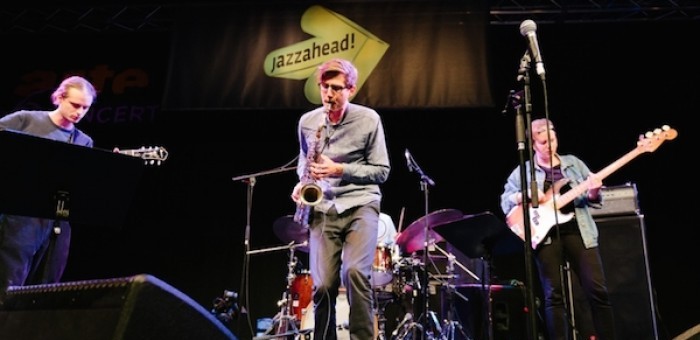Oct 28, 2025 10:47 AM
In Memoriam: Jack DeJohnette, 1942–2025
Jack DeJohnette, a bold and resourceful drummer and NEA Jazz Master who forged a unique vocabulary on the kit over his…

Dave Gisler (left), Florian Egli and Martina Berther of Weird Beard perform at this year’s Jazzahead! conference in Bremen, Germany.
(Photo: Jens Schlenker)One thread that emerged in the program was intriguing new variations on the piano trio tradition. In addition to memorable sets by Vallon and Held, there was the elastic, Bad Plus-ish Belgian LABtrio (kudos for their sneaky read on the “Twin Peaks” theme); the minimalist/textural vibing of Plaistow (from Switzerland) and the well-dressed, John Lewis-influenced elegance of a set from Aaron Diehl, who has made headlines for leading his trio and for working in vocalist Cécile McLorin Salvant’s band.
Indeed, one of the key takeaways from Jazzahead! was the notion that are still many ways to reconsider and parse the parts in the classic piano trio format.
On Saturday afternoon (April 23), before the showcase march began in unrelenting earnest, I sat down with Jazzahead! project manager Sybille Kornitschky and co-artistic director Beckerhoff to talk about their upwardly mobile venture.
Addressing the growth curve and future fate of the conference, Kornitschky spoke of the critical, delicate balance of what he described as “offer and demand.” He spoke of the professional relationships between attendees, emphasizing that they need one another: “Those who have something to offer here [include the] musicians. They need to be booked at festivals; so we need festivals, club owners and programmers. And of course, they need press and media people to talk about them. It all starts with the music, but then you need all those people who, for us, make the demand. So this is our work. It’s not only increasing the number of participants, but to be very careful in having a good balance between the offer and the demand.”
Beckerhoff, a trumpeter who was a music professor for 25 years, sees an important educational component to Jazzahead!, alongside its business aspects.
“Nowadays,” he noted, “every artist—whether it’s a musician, a painter or a writer—has to take care with the business part of the arts. The clever ones, the young ones—who may be a student at Berklee or Hamburg or wherever—should be aware that the world is not waiting for them. They have to show the world that they should wait. That [involves] what they play and how they play.
“But there are, of course, too many [musicians]. The market cannot be for everybody. This kind of competitive situation is something they are scared of and want to avoid. We are all scared. I tell them the first CD you bring into the market will compete immediately with [those from] the stars.
“This is what Jazzahead! is for, to show them how the market works. We can help them. There is also the matter of how to behave onstage. When we started, it was small, but now it’s worldwide, on a very high level. So we have well-educated musicians. They can play unbelievably well—not everybody, but at least an average of 30 percent can play to a very high standard.”
Kornitschky also addressed a pressing concern in Bremen: how to bring more of an American presence to the conference. Things are progressing on that front. There were five American artist showcases this year, including crowd-pleasing piano trios led by Diehl and Kevin Hays, and there was a U.S.-oriented zone on the conference floor, plus a DownBeat booth.
“We are working hard on the exchange between Europe and the U.S.A.,” she said. “America is the El Dorado for every single jazz musician, who hopes that one day, they would love to perform there. There is a dream, still. Our work here is to push these possibilities, to help this exchange, and of course, to have artists from the U.S. [perform in] the European market.”
Time will tell, as worlds within the jazz world meet again, next April in Bremen.

Jack DeJohnette boasted a musical resume that was as long as it was fearsome.
Oct 28, 2025 10:47 AM
Jack DeJohnette, a bold and resourceful drummer and NEA Jazz Master who forged a unique vocabulary on the kit over his…

D’Angelo achieved commercial and critical success experimenting with a fusion of jazz, funk, soul, R&B and hip-hop.
Oct 14, 2025 1:47 PM
D’Angelo, a Grammy-winning R&B and neo-soul singer, guitarist and pianist who exerted a profound influence on 21st…

Kandace Springs channeled Shirley Horn’s deliberate phrasing and sublime self-accompaniment during her set at this year’s Pittsburgh International Jazz Festival.
Sep 30, 2025 12:28 PM
Janis Burley, the Pittsburgh International Jazz Festival’s founder and artistic director, did not, as might be…

Jim McNeely’s singular body of work had a profound and lasting influence on many of today’s top jazz composers in the U.S. and in Europe.
Oct 7, 2025 3:40 PM
Pianist Jim McNeely, one of the most distinguished large ensemble jazz composers of his generation, died Sept. 26 at…

Drummond was cherished by generations of mainstream jazz listeners and bandleaders for his authoritative tonal presence, a defining quality of his style most apparent when he played his instrument unamplified.
Nov 4, 2025 11:39 AM
Ray Drummond, a first-call bassist who appeared on hundreds of albums as a sideman for some of the top names in jazz…